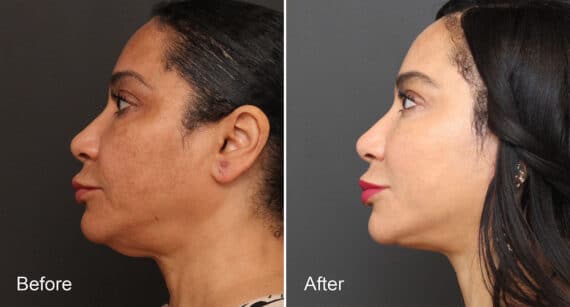A neck lift is a transformative cosmetic procedure that can improve the appearance of the neck and jawline. However, like any surgery, it’s important to have realistic expectations about the recovery process. In this blog, we will discuss the various stages of recovery after a neck lift, from immediate post-surgery care to the final results you can expect after a year. Understanding these phases can help you better manage your expectations and prepare for a successful outcome.

Understand Neck Lift Recovery Stages
- A neck lift recovery involves several phases, starting with initial swelling and bruising that subside within a few weeks.
- Most people resume normal activities within two to four weeks of a neck lift, but full healing can take several months.
- Keeping your head elevated and avoiding strenuous activity can help speed up the neck lift recovery process.
- It is essential to follow your surgeon’s post-operative care instructions to minimize the risk of complications after a neck lift.
- The final results of a neck lift may not be fully visible until all swelling has decreased, which can take a few months.
Understanding the Neck Lift Procedure
What Is a Neck Lift?
A neck lift procedure is a form of cosmetic surgery designed to improve the look of the neck. Ideal for those seeking options for neck rejuvenation, this outpatient procedure tightens loose skin, removes excess fat, and enhances the contour of the neck. It may also involve adjustments to muscles for a youthful appearance.
Benefits of Neck Lift Surgery
The goal of neck lift surgery is to create a smoother, more youthful, and contoured appearance. The entire neck lift surgery process is personalized for each individual. Key objectives include:
- Minimizing “turkey neck” by tightening skin.
- Removing fat that forms a double chin.
- Addressing platysma muscle banding.
- Sharpening the jawline for a clear transition to the face.
A neck lift can subtly improve your overall look and is often done alongside other facial surgeries. Each neck surgery aims to raise confidence and better reflect one’s youthfulness.
Immediate Post-Operative Phase (0-1 week)
Day 1: Surgery Completion and Initial Recovery
The Immediate Post-Operative Phase is essential for patients after a neck lift. On the surgery completion day, commonly called neck lift recovery day, many feel mild neck tenderness and discomfort. These symptoms are normal and can often be eased with pain relief strategies provided by the surgeon. To reduce swelling and support the neck lift recovery process, it is recommended to:
- Keep the head elevated, especially when resting, to help decrease swelling
- Apply ice packs, which are critical in managing swelling and neck bruising
Days 2-7: Progressing Through the First Week
Moving into the week, the neck lift recovery period may bring about a peak in swelling around the second or third-day post-surgery, which should then start to lessen. Patients must:
- Persist in the application of ice packs
- Continue keeping their head raised even while sleeping
- Adhere to the surgeon’s post-surgery care instructions for neck lift to aid neck incision healing
- Use a compression garment for additional neck support if recommended
Patients typically leave the hospital on the same day as the outpatient procedure. Advisable neck lift recovery practices involve limiting activities in the first week. Neck banding may occur, but this, along with bruising, progressively improves. Monitoring neck wounds for infection is important. Rest and vigilance for any unusual signs are key for effective recovery during this stage.
Short-Term Recovery Phase
The first four weeks after a neck lift mark the short-term recovery phase. This is where your body begins to heal. During the first month, it’s important to take care of the neck area to ensure a smooth recovery.
In the first two weeks, called the neck lift recovery period, swelling and discomfort are typical but will gradually lessen. Adhering to your surgeon’s instructions is vital for the healing of neck lift incisions and to minimize neck lift scars.
It’s advised to wear a support garment to help reduce swelling and provide support to the neck during recovery. You should also take prescribed medications and not miss any follow-up appointments.
Movement of the head and neck should be limited to prevent strain on the neck muscles. Engage only in light activities and steer clear of lifting or any strenuous exercise.
As weeks three and four progress, notable improvements should be visible. The neck lift recovery time sees an ongoing reduction in swelling, and the results of the surgical procedure become more evident. With permission from your surgeon, you might start engaging in daily activities and non-strenuous activities, while respecting any activity limitations.
By the end of the second month, incorporating regular activities, though with some restrictions, is usual. However, it’s crucial to continue avoiding vigorous and strenuous activity until you have the go-ahead from your healthcare provider.
Recommended practices throughout the recovery stage include:
- Regularly monitoring the healing process and reporting any issues.
- Managing swelling by adhering to post-operative instructions.
- Introducing usual tasks back into your routine with caution, abiding by your surgeon’s specific advice on activity.
- Ensuring proper neck care to promote healing.
Please remember that the neck lift recovery experience will differ for each individual, and closely following the post-operative instructions given by your surgeon will contribute to optimal results.
Patient Results
* All patients are unique and individual results may vary.
Intermediate Recovery Phase (1-3 months)
During the initial stages of the neck lift healing process, most patients see daily progress. The neck starts showing desired changes as swelling decreases, giving a glimpse of the rejuvenated shape. Within the first month, key steps include:
- Using cold compresses to manage and reduce swelling
- Gentle activities and adequate rest to aid circulation
- Following neck lift recovery tips, such as keeping the head elevated while sleeping to improve drainage
Regular adherence to these recommendations helps ensure a normal neck lift recovery and aids in minimizing neck lift scars. The progress one month into recovery shows a significant definition of the neck’s contour.
In months two and three, there’s a continued decrease in swelling, and incision healing becomes more noticeable. These changes are especially essential for those who undergo a mini neck lift, where less visible scarring is a feature.
To promote healing and avoid scar discoloration, maintaining skin care and protecting the skin from the sun is vital. By the end of the third month, patients typically observe:
- A steady fading of neck lift scars
- A further decrease in swelling, accentuating the neck’s shape
- Greater comfort with their neck’s appearance, which now reflects their expected results
The neck lift recovery time varies, but by this time frame, patients often witness substantial improvements toward their renewed look.
Long-Term Recovery Phase (3-6 months)
During the third month of the long-term recovery phase, patients typically see significant changes in their neck shape and contour. Improve neck mobility is often experienced as neck tightness decreases. By the end of this period, the results of a neck lift become clearer, with a more defined neckline emerging as visible swelling decreases.
By the sixth month, patients enjoy the benefits of their patience. Any remaining swelling has typically diminished, revealing a youthful neckline and the fading of neck lift scars. The neck concerns that prompted the treatment are no longer visible.
Improved neck mobility and the appearance of fainter neck lift scars affirm the successful outcomes of the procedure. As the sixth month marks the stabilization of the neck’s appearance, neck lift patients experience satisfaction with their exemplary neck lift results, free from the signs of neck aging that initially prompted the procedure.
Evaluating the Final Outcome After One Year
Long-Term Effectiveness of Neck Lift Surgery
Twelve months post-procedure, patients can fully assess the lasting effectiveness of their neck lift. The healing process is finished, and the permanence of clearer neck contouring can be seen. During the neck lift recovery journey, subtle transformations lead to less prominent neck aging signs.
Neck lift surgery offers enduring changes but does not promise the reversal of all neck aging signs. With the goals of refined contour and reduced neck bands, this period allows for reflection on the initial expectations set with the facial surgeon.
A facelift combined with a neck lift can enhance results, especially near the chin and jawline. Choices in makeup and hair now reflect personal style rather than attempts to cover neckbands. This stage can be a powerful shift for individuals who now see their necks without issue for the first time after many years.
Concerns should be directed to the cosmetic surgeon, but typically the real neck lift recovery reveals lasting improvements. The change impacts more than looks—it can boost self-image and confidence.
For expert guidance and exceptional results in your neck lift treatment, contact Becker Plastic Surgery today. Book a consultation to discover how our skilled surgeons can help you achieve your desired neck contouring goals.


